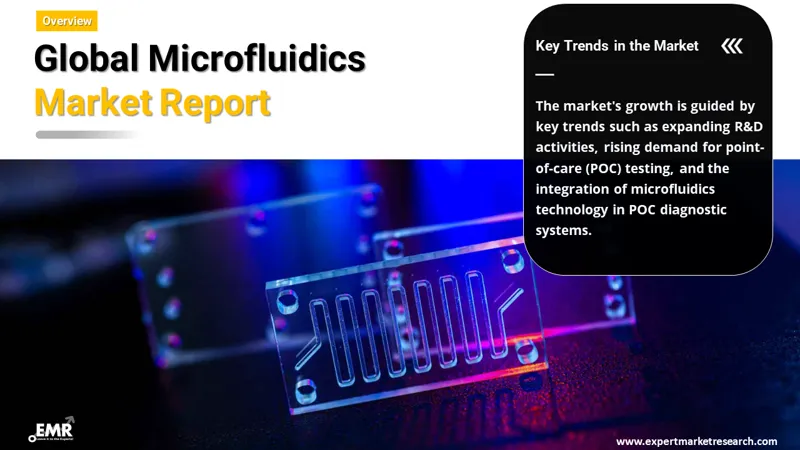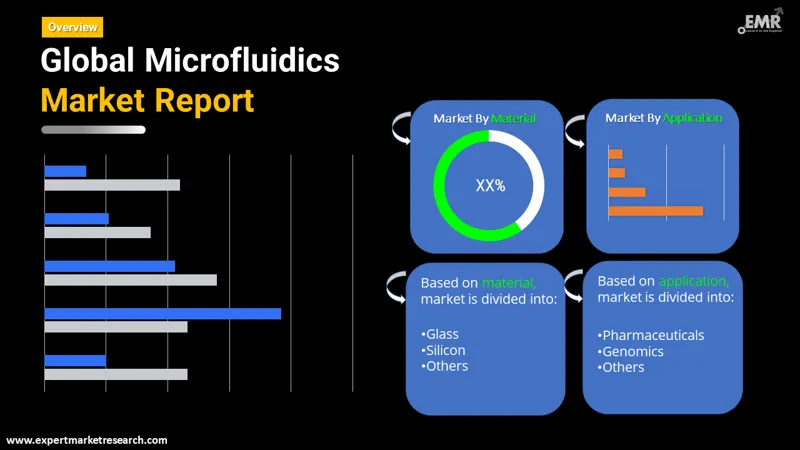
Consumer Insights
Uncover trends and behaviors shaping consumer choices today
Procurement Insights
Optimize your sourcing strategy with key market data
Industry Stats
Stay ahead with the latest trends and market analysis.
The microfluidics market was valued at USD 24.18 Billion in 2025, driven by growth in point-of-care diagnostics and lab-on-a-chip applications. The market is anticipated to grow at a CAGR of 7.80% during the forecast period of 2026-2035, with values likely to reach USD 51.24 Billion by 2035.
Base Year
Historical Period
Forecast Period
Compound Annual Growth Rate
7.8%
Value in USD Billion
2026-2035
*this image is indicative*
The growing prevalence of chronic and infectious illnesses, combined with advancements in coagulation testing, blood gas electrolytes, haematology, urine chemistry, and cardiovascular markers, are creating fresh possibilities for the development of the microfluidics market. The demand for microfluidics technology integration in POC diagnostic systems, manufacturing, fluid handling systems, and signal detection processes is increasing. In the coming years, this is anticipated to boost the microfluidics market further.

Read more about this report - REQUEST FREE SAMPLE COPY IN PDF
Microfluidics deals with the behaviour, accurate control, and manipulation of liquids that are geometrically restricted to a small scale, typically submillimeter, at which capillary penetration regulates mass transport. The global microfluidics market can be divided based on segments like material and application.
The industry can be divided based on its material as:
The microfluidics market can be broadly categorised on the basis of its application into:
Looks into the regional microfluidics markets like:

Read more about this report - REQUEST FREE SAMPLE COPY IN PDF
The rising demand for point-of-care (POC) testing due to the rising incidence of chronic infectious diseases, the growing demand for equipment integrated with microfluidic technology, faster testing and improved portability through microfluidic chip miniaturisation, and the development of innovative microfluidics technology, along with launch of new products, are some of the major factors driving the growth of the global microfluidics market. Challenges while incorporating the microfluidics technology into existing workflows coupled with the presence of complex and time-consuming regulatory standards are the factors which may restrain the growth of the microfluidics market up to some extent in the future.
The report presents a detailed analysis of the following key players in the global microfluidics market, looking into their capacity, competitive landscape, and latest developments like capacity expansions, plant turnarounds, and mergers and acquisitions:
The EMR report gives an in-depth insight into the microfluidics market by providing a SWOT analysis as well as an analysis of Porter’s Five Forces model.




*While we strive to always give you current and accurate information, the numbers depicted on the website are indicative and may differ from the actual numbers in the main report. At Expert Market Research, we aim to bring you the latest insights and trends in the market. Using our analyses and forecasts, stakeholders can understand the market dynamics, navigate challenges, and capitalize on opportunities to make data-driven strategic decisions.*
Get in touch with us for a customized solution tailored to your unique requirements and save upto 35%!
The market was valued at USD 24.18 Billion in 2025.
The market is anticipated to grow at a CAGR of 7.80% during the forecast period of 2026-2035, with the values likely to reach USD 51.24 Billion by 2035.
The major drivers of the market include the increasing population, growing incidences of chronic and infectious diseases, the developing healthcare sector, advancements in biotechnology, and growing clinical trials.
The key trends guiding the growth of the market include the growing R&D activities and increasing demand for point-of-care (POC) testing and the integration of microfluidics technology in POC diagnostic systems.
The major regions in the market are North America, Latin America, the Middle East and Africa, Europe, and the Asia Pacific.
The major materials of microfluidics considered in the market report are polymer, glass, and silicon, among others.
The significant applications of microfluidics include pharmaceuticals, genomics, proteomics, and cell based assays, among others.
The major players in the market are Illumina, Inc., Agilent Technologies Inc, Caliper Life Sciences, Cepheid, Danaher Corporation, Bio-Rad Laboratories, Inc., and Abbott Laboratories, among others.
Explore our key highlights of the report and gain a concise overview of key findings, trends, and actionable insights that will empower your strategic decisions.
| REPORT FEATURES | DETAILS |
| Base Year | 2025 |
| Historical Period | 2019-2025 |
| Forecast Period | 2026-2035 |
| Scope of the Report |
Historical and Forecast Trends, Industry Drivers and Constraints, Historical and Forecast Market Analysis by Segment
|
| Breakup by Material |
|
| Breakup by Application |
|
| Breakup by Region |
|
| Market Dynamics |
|
| Competitive Landscape |
|
| Companies Covered |
|
| Report Price and Purchase Option | Explore our purchase options that are best suited to your resources and industry needs. |
| Delivery Format | Delivered as an attached PDF and Excel through email, with an option of receiving an editable PPT, according to the purchase option. |
Single User License
One User
USD 5,499
USD 4,949
tax inclusive*
Datasheet
One User
USD 3,299
USD 2,969
tax inclusive*
Five User License
Five User
USD 6,999
USD 5,949
tax inclusive*
Corporate License
Unlimited Users
USD 8,199
USD 6,969
tax inclusive*
*Please note that the prices mentioned below are starting prices for each bundle type. Kindly contact our team for further details.*
Flash Bundle
Small Business Bundle
Growth Bundle
Enterprise Bundle
*Please note that the prices mentioned below are starting prices for each bundle type. Kindly contact our team for further details.*
Flash Bundle
Number of Reports: 3
20%
tax inclusive*
Small Business Bundle
Number of Reports: 5
25%
tax inclusive*
Growth Bundle
Number of Reports: 8
30%
tax inclusive*
Enterprise Bundle
Number of Reports: 10
35%
tax inclusive*
How To Order

Select License Type
Choose the right license for your needs and access rights.

Click on ‘Buy Now’
Add the report to your cart with one click and proceed to register.

Select Mode of Payment
Choose a payment option for a secure checkout. You will be redirected accordingly.
Gain insights to stay ahead and seize opportunities.

Get insights & trends for a competitive edge.

Track prices with detailed trend reports.

Analyse trade data for supply chain insights.

Leverage cost reports for smart savings

Enhance supply chain with partnerships.

Connect For More Information
Our expert team of analysts will offer full support and resolve any queries regarding the report, before and after the purchase.
Our expert team of analysts will offer full support and resolve any queries regarding the report, before and after the purchase.
We employ meticulous research methods, blending advanced analytics and expert insights to deliver accurate, actionable industry intelligence, staying ahead of competitors.
Our skilled analysts offer unparalleled competitive advantage with detailed insights on current and emerging markets, ensuring your strategic edge.
We offer an in-depth yet simplified presentation of industry insights and analysis to meet your specific requirements effectively.
Share